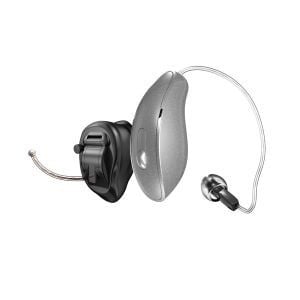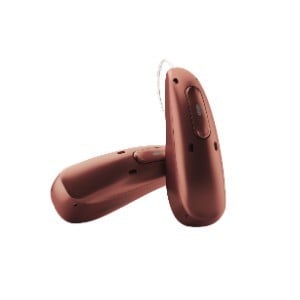
Head of Online Medical Content

Audiology Expert at Hearing Aid UK
Comparing Oticon Intent hearing aids with Oticon Real
What's the difference between the two?
Overview | Technology | Upgrades | Conclusion
Compare Intent with Real
Oticon launched Oticon Intent in February 2024, just one year after the release of Oticon Real hearing aids. We compare both the Intent vs Real miniRITE models in our comparison table below, but in this article, we also delve into what has stayed the same, what has changed and what are the advantages of opting for the latest offering from Oticon.
Sensor and directionality technology
Intent brought the new 4D sensor technology to the table allowing these hearing aids to learn from your head and body movements and adapt your soundscape accordingly so you can gain from better speech understanding in noise. For example, Oticon claims that premium hearing is more than just sound, understanding the wearer is also an important part of someone's listening experience.
This is because different hearing loss levels need unique support, so even though two people with hearing loss can be in the same listening environment, they both need their hearing aids to work differently. In theory, Intent understands your listening intention, therefore you will benefit from truly personalised hearing that deals with your distinct requirements.
Oticon Real doesn't have this advanced sensor and directional technology, its main focus, at launch, was solving key pains for hearing aid wearers. Such as sudden, disruptive, and uncomfortable sounds, which unsurprisingly, are what most users are bothered by.
However, this does mean that the directionality of Real is no different from the other hearing aid brands out there and arguably not as good as potentially the Signia Pure IX or Resound Nexia ranges.
The upgrades
The upgrades seen in Oticon Intent, such as the new Sirius processing chip and Deep Neural Network 2.0 (DNN) all contribute to better sound quality, speech clarity, and efficiency in noise suppression. For example, improved preservation of original sound which gives you a reduction in cue losses for both noise and speech.
Intent also raised the bar in frequency response from 80 Hz to 10 kHz. Theoretically, this should mean you'll benefit from a richer sound experience than you would with Oticon Real.
The new MoreSound intelligence technology and next-generation MoreSound Amplifier 3.0 in Intent are said to offer a reduced base noise along with better high-frequency response and dynamic range when compared to Real. Arguably, this could rival Starkey Genesis AI in these areas.
Oticon Real introduced one of the best feedback suppression algorithms, however, Intent develops this further with an even smarter algorithm to control feedback - all made possible without compromising on speech understanding or sound quality.
Sound-to-noise ratio
Oticon Intent also brought a 1 to 5 dB increase in SNR, which means, when compared to Oticon Real, you should understand speech 5 dB better and benefit from (along with the 4D sensor technology):
- 10 % better listening comfort
- 10% better sound quality
- 13% better nuance in the soundscape
- 15% better speech understanding
- 35% better access to speech cues
Other features that might tempt you when comparing Oticon Intent with Real
- The 13 battery means there is around 33% more charge on the go versus Real
- New smaller miniRITE than Oticon Real
- Intent is Bluetooth LE Audio and Auracast future-proof
![]()
![]()
Conclusion
If you have already invested in Oticon Real, it wouldn't make sense to now upgrade to Intent - especially since Real is only a year old. Wait a bit longer, Real is still a really good aid and both the wind cancellation and sudden sound control are some of the best in the industry.
However, if you are looking to upgrade your existing aids, Intent is definitely worth considering. It has pretty much closed a lot of gaps in Oticon Real and is going to make a real difference when hearing in challenging environments.
The 4D technology goes beyond just hearing, as it adapts sound processing according to your unique listening needs to support you better in communication and engagement. The MoreSound technology will also give you access to a more accurate interpretation of sound in the brain, a richer representation of your environment, and a bigger scope of all sounds.
If you are tempted....
There are a few things to consider when looking at Oticon Intent's performance levels. The 4D speech enhancer is only available in levels 1 and 2. Therefore, if speech understanding is important to you - look to these levels.
Spatial balance, the feature that will give you the most capability in challenging listening environments is only available in level 1.
The neural noise suppression continues to drop after level 1 (12 dB) as you go down the performance levels. If you work in a noisy environment or your biggest challenge is hearing through the noise - level 1 would be the best performance for you.
All levels include advanced Bluetooth technology and both wind and sudden noise cancellation but the last level, level 4, is missing the tap control feature. For a breakdown of important features and benefits of both ranges, take a look at the comparison chart below.
Why Choose Us?
- FREE Hearing Tests
- Best Hearing Aids and Prices
- FREE Aftercare for Life
- FREE Home Visits
- 200+ Local Audiologists
- 60 Day Money Back Guarantee
Comparison table for Oticon Intent and Real hearing aids
Intent vs Real hearing aids
Hearing aid technology advances constantly and it's important to know when it's time to replace the ones you already have. For example, you might find that your current hearing aids aren't supporting your hearing like they used to.
This might be because your hearing loss has changed and you now need more features and programmes that aren't accessible to you.
Our audiologists can help you understand your new hearing loss needs and specifications and the hearing solutions that can get your hearing back on track.
Other hearing aid technology articles you might like...
 Starkey Edge AI Hearing Aids VS Starkey Genesis AI
Starkey Edge AI Hearing Aids VS Starkey Genesis AI  Phonak Audeo Infinio VS Phonak Lumity Hearing Aids
Phonak Audeo Infinio VS Phonak Lumity Hearing Aids  What is Auracast? Is it better than Classic Bluetooth?
What is Auracast? Is it better than Classic Bluetooth? Our specialist service includes:
Do not spend hundreds of pounds without getting a second opinion from us.
Please call us on 0800 567 7621
 Not only are the prices great, but the service is fantastic! Many thanks to your team.
Not only are the prices great, but the service is fantastic! Many thanks to your team.What's included in our hearing aid prices?
Common FAQs about hearing aids and hearing loss
If you are looking at this page then it is likely that an audiologist has suggested that you purchase this particular hearing aid, so is this the best model for you?
In general, any audiologist will always recommend to you the model that best suits your needs. Here is a useful checklist to make sure that is the case.
- Audiologist level of knowledge: The audiologist you have seen will hopefully have a wide knowledge of all available hearing aids, however, some will only be familiar with a small number of brands and therefore may not really be in a position to know which model is the best for you. It is OK to challenge their recommendation and ask them to justify why this particular brand is the one for you.
- Do research: Read about the hearing aid that was recommended. Does it seem like it will suit your lifestyle? Does it have more or fewer features than you need?
- Be aware of sales targets: Many high street retailers have specific tie-ins to a particular manufacturer/brand. The hearing aid they have suggested may still be the correct one for you, but do your research so that you know why they might have recommended it.
If in doubt, feel free to give us a call. That's what we're here for. In the meantime, read all about our review of the best hearing aids for 2025 here
If you have significant hearing loss in both ears, you should be wearing two hearing aids. Here are the audiological reasons why:
Localisation: The brain decodes information from both ears and compares and contrasts them. By analysing the minuscule time delays as well as the difference in the loudness of each sound reaching the ears, the person is able to accurately locate a sound source. Simply put, if you have better hearing on one side than the other, you can't accurately tell what direction sounds are coming from.
Less amplification is required: A phenomenon known as “binaural summation” means that the hearing aids can be set at a lower and more natural volume setting than if you wore only one hearing aid.
Head shadow effect: High frequencies, the part of your hearing that gives clarity and meaning to speech sounds, cannot bend around your head. Only low frequencies can. Therefore if someone is talking on your unaided side you are likely to hear that they are speaking, but be unable to tell what they have said.
Noise reduction: The brain has its own built-in noise reduction which is only really effective when it is receiving information from both ears. If only one ear is aided, even with the best hearing aid in the world, it will be difficult for you to hear in background noise as your brain is trying to retain all of the sounds (including background noise) rather than filtering it out.
Sound quality: We are designed to hear in stereo. Only hearing from one side sounds a lot less natural to us.
Fancy some further reading on this topic? You can read about why two hearing aids are better than one in our article, hearing aids for both ears, here
For most people, the main benefit of a rechargeable hearing aid is simple convenience. We are used to plugging in our phones and other devices overnight for them to charge up. Here are some other pros and cons:
For anybody with poor dexterity or issues with their fingers, having a rechargeable aid makes a huge difference as normal hearing aid batteries are quite small and some people find them fiddly to change.
One downside is that if you forget to charge your hearing aid, then it is a problem that can't be instantly fixed. For most a 30-minute charge will get you at least two or three hours of hearing, but if you are the type of person who is likely to forget to plug them in regularly then you're probably better off with standard batteries.
Rechargeable aids are also a little bit bigger and are only available in Behind the Ear models.
Finally, just like with a mobile phone, the amount of charge you get on day one is not going to be the same as you get a few years down the line. Be sure to ask what the policy is with the manufacturer warranty when it comes to replacing the battery.
Looking for more information on rechargeable hearing aids? Read our dedicated page on the topic here
For most people, the answer is yes. But it's never that simple.
The majority of hearing problems affect the high frequencies a lot more than the low ones. Therefore open fitting hearing aids sound a lot more natural and ones that block your ears up can make your own voice sound like you are talking with your head in a bucket. Therefore in-ear aids tend to be less natural.
However the true answer is we can't tell until we have had a look in your ears to assess the size of your ear canal, and until we have tested your hearing to see which frequencies are being affected.
People with wider ear canals tend to have more flexibility, also there are open fitting modular CIC hearing aids now that do not block your ears.
There is also the age old rule to consider, that a hearing aid will not help you if it's sat in the drawer gathering dust. If the only hearing aid you would be happy wearing is one that people can't see, then that's what you should get.
Most people can adapt to any type of hearing aid, as long as they know what to expect. Have an honest conversation with your audiologist as to what your needs are.
Generally speaking, six or more. Unless it's none at all.
The number of channels a hearing aid has is often a simplistic way an audiologist will use to explain why one hearing aid is better than another, but channels are complex and it is really not that straightforward. Here are some reasons why:
Hearing aids amplify sounds of different frequencies by different amounts. Most people have lost more high frequencies than low and therefore need more amplification in the high frequencies. The range of sounds you hear are split into frequency bands or channels and the hearing aids are set to provide the right amount of hearing at each frequency level.
Less than six channels and this cannot be done with much accuracy, so six is the magic number. However, a six channel aid is typically very basic with few other features and is suitable only for hearing a single speaker in a quiet room. The number of channels is not what you should be looking at, it's more the rest of the technology that comes with them.
As a final note, different manufacturers have different approaches. One method is not necessarily better than any other. For example, some manufacturers have as many as 64 channels in their top aids. Most tend to have between 17 and 20. One manufacturer has no channels at all.
Hearing aids are easily lost, misplaced or damaged and typically are one of the most expensive personal possessions an individual can own. We offer hearing aid warranty coverage for £80 per year per aid. Find out more about this service we provide here
All our audiologists use the very latest technology and provide the full range of tests to accurately measure your hearing for free. Find out about what hearing healthcare services we offer all our customers here
Hearing Aid UK offers all their customers free home visiting services, even in a care home environment, for no extra cost. Including hearing tests, fittings, maintenance, check-ups and much more in the comfort of your own home and at your convenience. Find out more information about our home visits here
Here, at Hearing Aid UK, we are dedicated to offering low hearing aid prices. We achieve this by having no head office and low marketing costs. Our hearing aid prices are amongst the lowest you will find anywhere in the world. Explore our prices, brands, and models here
Other pages you might find useful
Ask the Experts
6 Morton Lane
Walkwood
Redditch
Worcestershire
B97 5QA
Latest Launch
When we refer to a product as 'Latest Launch', we mean it is the latest to be released on the market.
New
When we refer to a product as 'New', we mean that the product is the newest hearing aid model on the market.
When we refer to a product as 'Superseded', we mean that there is a newer range available which replaces and improves on this product.
Older Model
When we refer to a product as an 'Older Model', we mean that it is has been superseded by at least two more recent hearing aid ranges.
